A definitive description of the Ideal Fantail pigeon
1.0 Body
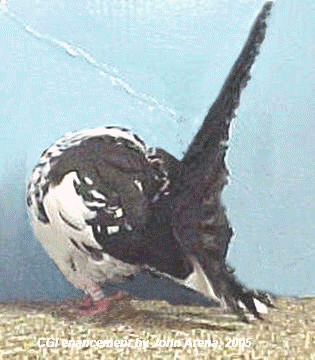 The body should be circular when viewed from any angle. In
profile, an even curve should be observed beginning at the beak, rising over the
chest, and continuing over the underbelly to end at the feet. The body should
feel compact and hard when handled.
The body should be circular when viewed from any angle. In
profile, an even curve should be observed beginning at the beak, rising over the
chest, and continuing over the underbelly to end at the feet. The body should
feel compact and hard when handled.
1.1 Keel
A relatively short keel is desired. Its structure is such that it allows the chest and underbelly to extend in front of the wings when viewed in profile. The overall image is one of roundness.
1.2 Back
Should give the appearance of being slightly hollow in the centre. The length of the back should be in proportion to the length of neck so as to allow the head to rest centrally at the base of the fore cushion. This position is referred to as the "pocket".
1.3 Rump
The rump should be of sufficient size and shape, such that it presents a sound foundation for the setting of the tail and rump feathers. The strength of the rump should be such that it allows the tail to be carried erect, "peacock like", displaying the spread tail feathers to maximum advantage. Rump position should be such that the head can "pocket" easily and consistently
1.4 Wings
The wings should be narrow and refined, carried well up and tight to the body with the tips of the flights resting gently on the floor. Wingtips nearly meeting behind the tail. When viewed from the front, there should be no wing or flight coarseness, the wings contributing to an overall illusion of body roundness by being well covered with body feather.
When seen in profile, wing placement should be such that it allows the maximum amount of body frontal to be seen with some lower leg and thigh also exposed. The lower edge of the wing should present an unbroken curve from the tip of the flights through to the lower edge of the wing butt . Wing butts are covered with body feather such that they are obscured when the bird is viewed both in profile and from the front.
Faults:
Body- slab sided or pear shaped body when viewed from the front , lacking in roundness and depth, too tall.
Keel - too long, resulting in a body shape that does not describe a circle from all angles, split keel, crooked keel.
Back - too short resulting in the tail being carried over the head like an umbrella i.e. "pot-lidder" (can also be caused by poor leg placement - see legs).
Rump - set too high resulting in no room for the bird to pocket deep and thus, allowing the head to be seen when viewed from the front. Low rump setting result in "sled runner" wings, over styling.
Wings - set too high, resulting in the bird opening up in the front when styling or presenting coarse wing butts when viewed from front on; set too low the wings will exhibit a broken wing line as the flights exert excessive pressure on the ground when the bird is styling; presence of pinholes or lice in feathers
2.0 Tail
The tail is slightly concave, circular and closely filled with broad (~ 1.5") feathers that have strong quills and webbing and are evenly set. From the shoeing feathers on either side of the tail, the webbing of each feather should overlap the next in line by a generous amount. Tails should be laced prior to the bird being placed into the Walking pen.
Faults: Wry tail i.e. the tail is not straight when viewed from above, or tilted to either side when viewed from the rear or front, soft feather, tail scooped or funnel shaped, too small, inadequate or too much shoeing, uneven set of tail feathers, tail feathers too thin, missing feathers, weak centre, presence of pinholes or lice in feathers.
2.1 Front and Rear Cushions
Both cushions should be centrally positioned strong, massive, flaring outwardly and upwardly from the rump . They should be well filled with strong feathers (particularly the rear cushion) that extend well up the tail and are evenly spaced.
Faults: front or rear cushion; too small, too narrow, lacking in feather.; wryness i.e. tilting to either side
2.2 Tail size to Body size Ratio
Tail width should be proportional to body width and in balance with the other characteristics. A body width to tail width ratio of 1:3 seems to present a very attractive image particularly on a bird with a 4" body width (including the wings).
3.0 Head
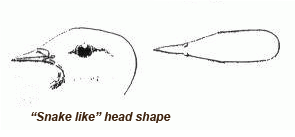 The head should be small, fine, neat and free of
ornaments such as peaks or crests of any description. A "snake like" head with
very little fore skull is
preferred. Rear of head should blend into the neckline
The head should be small, fine, neat and free of
ornaments such as peaks or crests of any description. A "snake like" head with
very little fore skull is
preferred. Rear of head should blend into the neckline
Faults: Excessive fore skull i.e. "Tumbler or Homer shaped"; presence of crest or peak


3.1 Beak
The beak should be thin and medium in length,
Faults: Coarse, crooked or cross beak; untrimmed mandibles (minor)
3.2 Beak Wattle
Small and fine in texture
Faults: Large, coarse wattle
3.3 Eyes
Clear, bright, alert. Eyes should be dark for all white headed colours. Pearl eyes are preferred for all other colours, however yellow to orange-red eyes are also permitted.
Faults: Each eye having a different colour, split iris
3.4 Eye Cere
Eye cere should be as fine as possible and coloured in accordance to feather colour.
Faults: Eye cere too coarse, red ceres
3. 5 Neck and Headset
The neck should be thin, nicely curved and tapering well off as it approaches the head. Length of neck should correspond with length of the back so as to enable the head to set consistently and effortlessly in the centre of the base of the cushion. This head position shall be known as the "pocket".
Beak line should flow into the curve of the body profile. Head must not be visible above the chest when the bird is viewed from the front and at eye level. When viewed in profile, the head should be positioned well beneath the top of the chest.
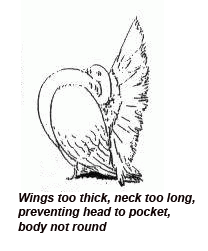

Faults: Head above the chest, setting off centre i.e. leaning to right or left or unable to pocket correctly. This may indicate that the back is too short, rump set too high or the neck too long or short.
4.0 Legs and Feet
The legs and leg setting of a fantail are of paramount importance. A truly round and circular body cannot be adequately supported if the legs are incorrect. Without strong legs that are widely set, a fantail is at a considerable disadvantage when it comes to performing in the Walking pen.
4.1 Legs
The legs should be strong, moderately short to medium in length. They should not give the appearance of "stiltedness". Legs should be set well apart and forward so as to conform with the curve of the body line without the appearance of "buckling", bowed in, or spreading out past the width of the body.
A fantail in show position i.e. "rolled up" or "digging", should have its legs placed well apart and parallel.
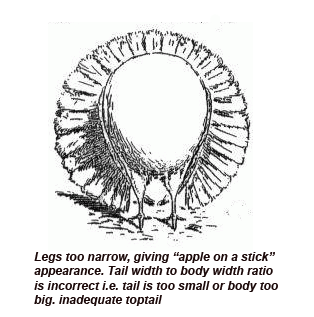
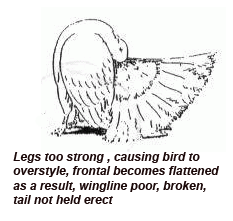
Faults: Cow hocks; pigeon toed.; bird unable to roll up without having one leg placed well behind the other i.e. pulled back; buckling at the "knee" joints; legs set too far back on the body, causing the bird to tip forward (in extreme cases this results in the bird carrying its tail in an umbrella like fashion i.e. it becomes "pot-lidded). Legs set too close together.
4.2 Feet
Strong, fine and neat, free from feathers and bright red in colour. When standing, the birds weight should be set confidently on the front toes. The ball of the foot should be slightly on the floor. The feet should be parallel, not one pulled back or turned in i.e. pigeon toed.
Faults: flat feet, pigeon toed, presence of grousing; feet not parallel when styling; birds displaying webbed feet or other foot deformities (should be disqualified and not used for breeding).
5.0 Plumage
Clean, neat, hard and tight fitting, with no "pants" or loose feathers obscuring the lower legs. The tail and cushion feathers should be long and hard to the feel. All other feathers on the bird should be short including the flights. Plumage pigmentation and markings to comply with recognised colour descriptions.
Faults: Loose feather giving the bird a "fluffy" feel when handled; pants or loose underbelly feather obscuring legs; excessively long flight feathers; lacking desired proper pigmentation and markings; soft tail feather.
6.0 Performance and Visual appearance of the Modern Fantail
6.1 Carriage
When "styling" or "digging" a fantail should present a neat, refined, petite and balanced appearance. It should not appear overly coarse. The head should be centralised and held deep in the pocket.
The body must present a circular appearance from all angles and, when viewed in profile, an even curve should be evident which begins at the beak, rises over the chest, and continues over the underbelly to end at the base of the feet.
The wings should be refined (i.e. narrow across the coverts and secondary feathers), carried well up and tight to the body. When viewed from the front, there should be no wing or flight coarseness, the wings contributing to an overall illusion of circular body roundness. Wing placement should be such that it allows some lower leg and thigh to be seen. When viewed in profile, the lower edge of the wing should present an unbroken curve from the tip of the flights through to the wing butt. Wing butts are covered with body feather such that they are obscured when the bird is viewed both in profile and from the front.
The legs are parallel, spaced widely, and the bird up on its toes.
The tail and rump should be carried well up such that the amount of top tail visible when viewed from front on is maximised.
All characteristics mentioned above are in balance with no one characteristic in excess. A balanced, refined and neat appearance being the desired visual.
Faults: Opening up in the front when styling (legs too strong or rump set too low); inability to style due to short back or legs set too far back ;spinning due to incorrect tail lacing i.e. too tight or loose, or having some other characteristic out of balance; flighty or overly nervous due to inadequate pen training; presented in a dirty condition; presenting coarse flights, flat chested; lacking circular roundness due to inadequate frontal and underbelly; inbalance in characteristics i.e. tail too small or large;long flights; neck too long; rump too weak (wryness) or set too high (pot lidding) or low (sled runner wings).
6.2 Carriage in Motion
Carriage in motion relates to the behaviour and carriage of a Fantail whilst it is parading or walking. Fantails should walk in bright and positive fashion, the bird appearing composed, relaxed and in control of its actions. During the parade, the bird should maintain composure i.e. holding wings tight and close to the body with the head pocketing well down in the pocket There should not be any undue nervousness. Correct carriage in motion can only be achieved if all characteristics that make up an exhibition fantail are in harmonious balance with one another.
John Arena, December 2005 (Contact me: mailto:jarena59@aapt.net.au).